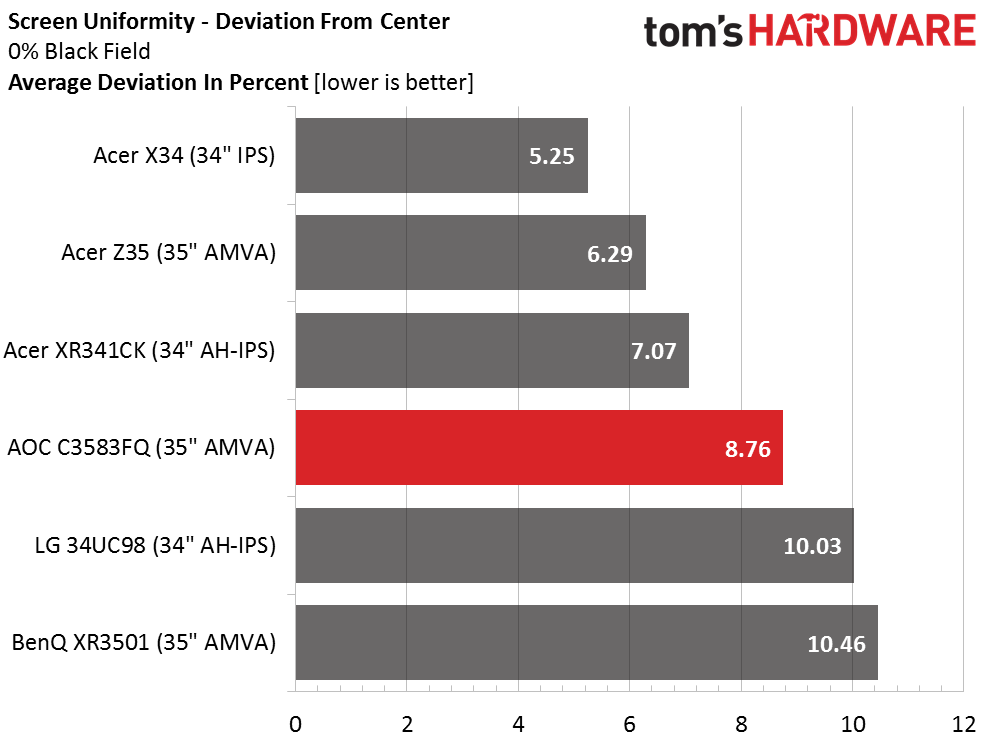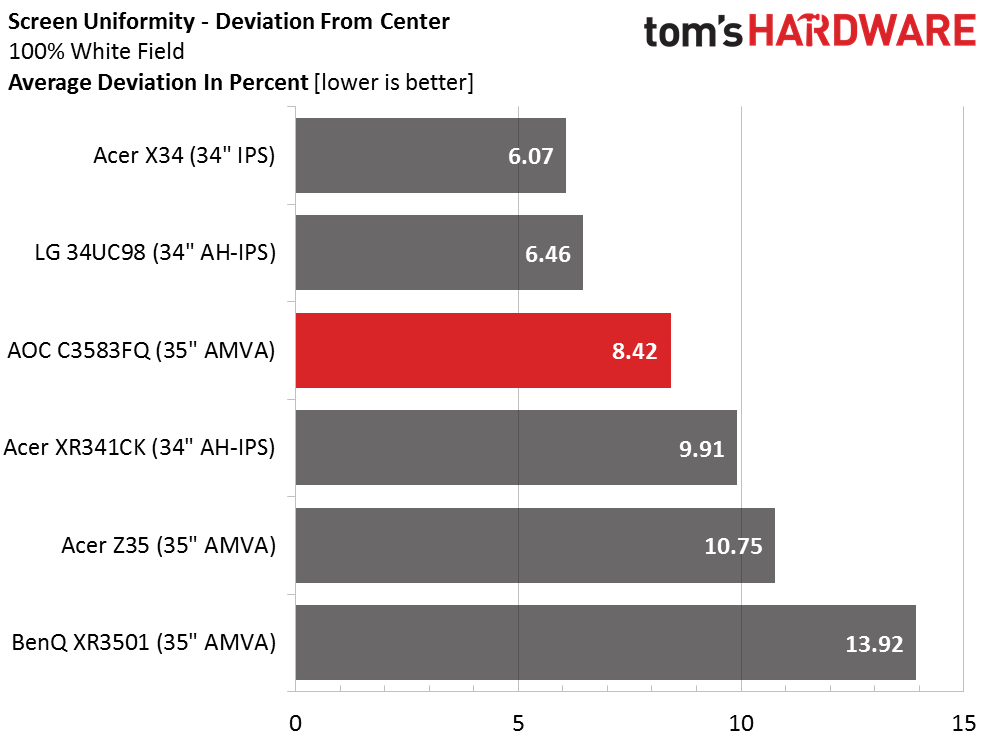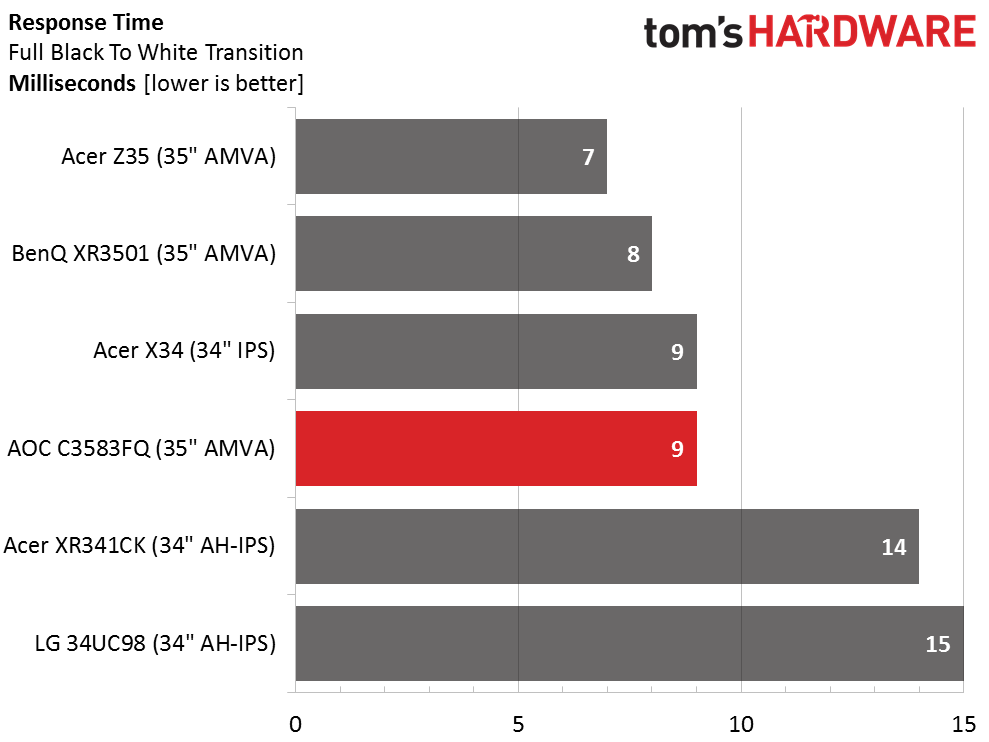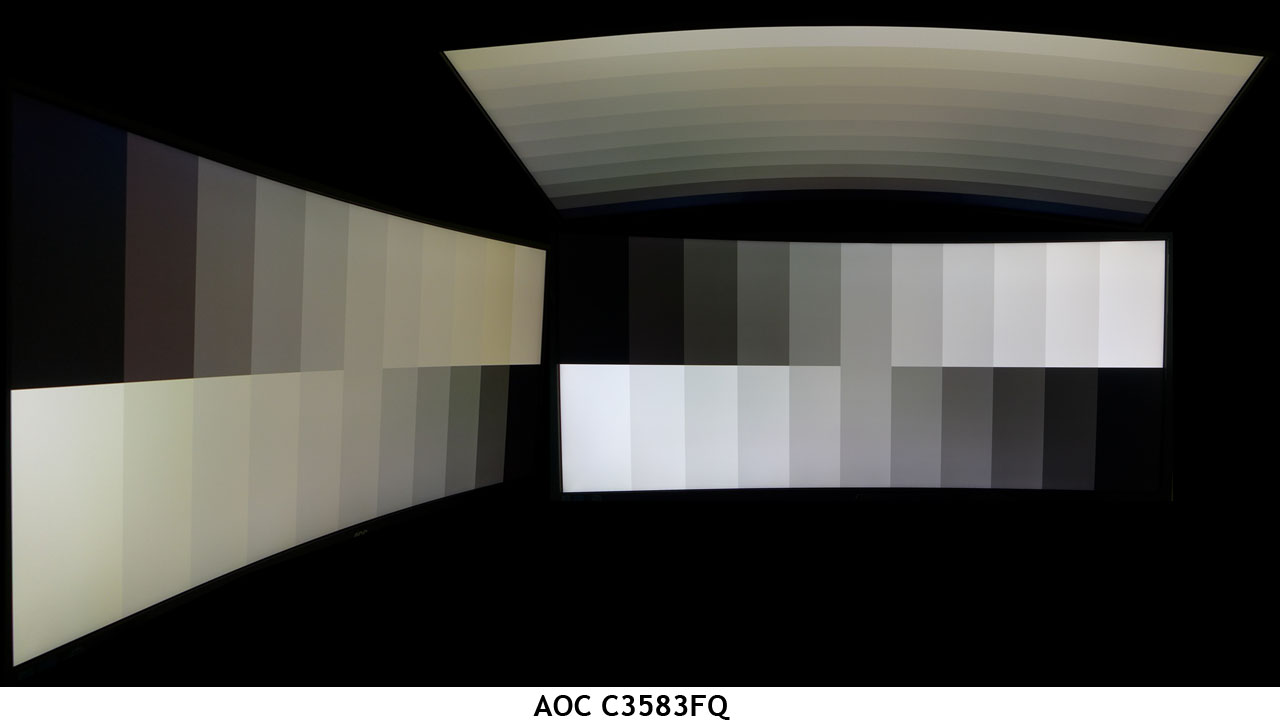AOC C3583FQ 35-inch Curved Ultra-Wide FreeSync Monitor Review
Is price still preventing you from picking up a curved ultra-wide monitor? You might want to check out AOC’s 35-inch C3583FQ selling for only $600. We’re checking out this 160Hz FreeSync screen in our lab today.
Why you can trust Tom's Hardware
Viewing Angles, Uniformity, Lag And Gaming Tests
To learn how we measure screen uniformity, please click here.
AMVA is a bit weak in the viewing angle department, falling squarely between IPS and TN in quality. It’s not a deal-breaker by any means, and we saw no issues at normal viewing distances with real-world content. At 45 degrees to the side, you’ll see a shift to red and green and an obvious light falloff. There is no loss of detail however. From the top, the color change is similar and gamma is visibly affected. You can still see all the brightness steps, but only barely. We still feel the C3583FQ, or any other AMVA curved monitor, is well-qualified for a multi-screen installation.
Screen Uniformity



Artifacts like backlight bleed or IPS glow can really affect games and video content that contain a lot of dark shadowy material. Even when a monitor sports high contrast, these anomalies can be a spoiler. Fortunately the C3583FQ has none of these problems. Both the white and black field tests yield results comfortably below 10%. In looking over the raw data, there are slightly-hot zones in the center (top to bottom), which is likely a function of the tight 2000R curvature.
Color uniformity is about average among all the monitors we’ve tested. It seems that neither the curve nor the AMVA technology has any effect on the result. A 2.10dE variation is invisible to the naked eye and puts the AOC mid-pack in today’s group of ultra-wide screens.
Pixel Response And Input Lag
Please click here to read up on our pixel response and input lag testing procedures.


The C3583FQ offers a maximum refresh rate of 160Hz, which in our experience is the highest currently available in the FreeSync category. Given its 2560x1080 resolution, it shouldn’t be too hard to approach 160fps with a high-end GPU. That’s where you’ll find the lowest level of motion blur and the least latency. We performed our tests at 160Hz and recorded mid-level results: 9ms for the screen draw and 34ms total input lag.
The top finisher is the G-Sync Acer Z35, but there’s that price premium again. The BenQ XR3501 doesn’t offer adaptive refresh but it does top out at 144Hz which makes tearing almost a non-issue. But it too costs more. AOC has really made a price breakthrough here. Considering these results, it’s hard not to call it a performance bargain.
Get Tom's Hardware's best news and in-depth reviews, straight to your inbox.
Gaming With FreeSync
The C3583FQ’s lower limit of 45Hz might seem at first glance to be a liability, but don’t forget its relatively low resolution. Pushing 2.76 mega-pixels doesn’t require a ton of processing horsepower. Achieving high framerates won’t be that difficult or expensive. As always, we start our gaming tests by adjusting detail levels to find a monitor’s motion-processing sweet spot. Since 160Hz means the sky’s the limit, we started with Far Cry 4 on High detail.
This game has a lot of organic and detailed textures but they are mostly viewed from afar. Things like leafy trees and grassy slopes retained their sharpness even when the mouse was moved quickly. Overdrive should be left at its medium setting to avoid ghosting. The Strong option results in annoying ringing even when motion is slow. Framerates stayed comfortably above 45fps so we never saw any tearing. We weren’t able to explore higher speeds here, however. The processing requirements are beyond the capabilities of our Radeon R9 285.
Tomb Raider on the other hand will maintain 100fps or greater even when game play gets intense. On its high detail setting we enjoyed a very smooth experience with no perceived latency whatsoever. We did notice a little smearing however when moving close to complex textures like stones or moss. It was an initial disappointment, but after playing a while we found it easy to ignore thanks to the game’s quick responses and stutter-free movement.
Battlefield 4 provided a similar experience and since its graphics are more industrial looking, there was no softening, even when we moved the mouse rapidly. We were able to ratchet detail up to Very High with framerates still hovering around 100.
It’s a forgone conclusion that users with high-end GPUs should have little trouble setting their games up for maximum detail and extremely high framerates. This kind of smoothness, coupled with the wraparound feel of the C3583FQ’s 2000R curvature, can really add to a game’s realism and suspension of disbelief.
Current page: Viewing Angles, Uniformity, Lag And Gaming Tests
Prev Page Grayscale, Gamma And Color Next Page Conclusion
Christian Eberle is a Contributing Editor for Tom's Hardware US. He's a veteran reviewer of A/V equipment, specializing in monitors. Christian began his obsession with tech when he built his first PC in 1991, a 286 running DOS 3.0 at a blazing 12MHz. In 2006, he undertook training from the Imaging Science Foundation in video calibration and testing and thus started a passion for precise imaging that persists to this day. He is also a professional musician with a degree from the New England Conservatory as a classical bassoonist which he used to good effect as a performer with the West Point Army Band from 1987 to 2013. He enjoys watching movies and listening to high-end audio in his custom-built home theater and can be seen riding trails near his home on a race-ready ICE VTX recumbent trike. Christian enjoys the endless summer in Florida where he lives with his wife and Chihuahua and plays with orchestras around the state.
-
psycher1 Lost me at 1080. I don't care about the size at that point, 1080 anything shouldn't be above $300 today.Reply
And at 35''? With this, you're going to get $600 of near CRT size pixels. I have a 27'' ($250) and, with it on my desk in front of me, pixels are already easily defined. In game as well, it's the one element holding back my otherwise stunning experience in W3 right now.
Add another 8'' to that, without enhancing the resolution, it'd be too much.
The only benefit I can see is if you sit far away from the screen (e.g. couch on the other side of the room) and watch movies with people (using something like VLC to zoom already 21:9 movies to fill the screen). -
realibrad You guys realize this is not a 1920x1080 monitor right? This monitor has 33% more pixles than a 1080 monitor. If you dont think 33% is a big enough jump, then realize that a 1440 (2560x1440) is only 33% above this monitory.Reply
So, those who say things like 1080 whaaaaa, just know that you do not know what you are talking about. If the height matters so much to you, I would gladly sell you my 1920 monitor...*rotates monitor 90 degrees. -
ohim @BIBBIT You can use it without issues on an Nvidia card, you just won`t benefit from the FreeSync specs.Reply
the monitor is a failure due to resolution, 35" and 2560*1080 is very poor.
My 21:9 34" LG monitor has 3440x1440 ~ 110 ppi
a typical 24" 1080 screen has ~91 ppi
this monitor has 79 ppi
The resolution is crap, you`ll be able to see the individual pixels on the monitor while working on it ... i wouldn`t recommend this monitor to anybody. -
Sam Hain Concerns with 1080p can be negated with DSR settings (2k & 4k sim-rez) when gaming and it's FREE... It's a relatively SIMPLE setup-process that produces pretty decent results and for $600, you can't complain about that.Reply
If a 1080p monitor were placed in DSR x1.78 and the markings were removed from the monitor and a game were running on it, with appropriate graphics settings applied to the corresponding GPU, you'd have a hard time distinguishing it from an actual 1440p monitor or a 4k one for that matter when DSR'd.
Pixel density... Unless you're sitting within 18 inches or have your mug right up on the monitor, you're not going to notice this when it's in 1080p on the desktop, web, word-processing, programs, etc.
My .02 cents... Spend your $1K on a monitor that WILL have glow issues while this monitor will allow $400 to be applied elsewhere in a system/upgrades or a GPU upgrade down the road and still have performance to match that the naked eye may or may not be able to discern.
